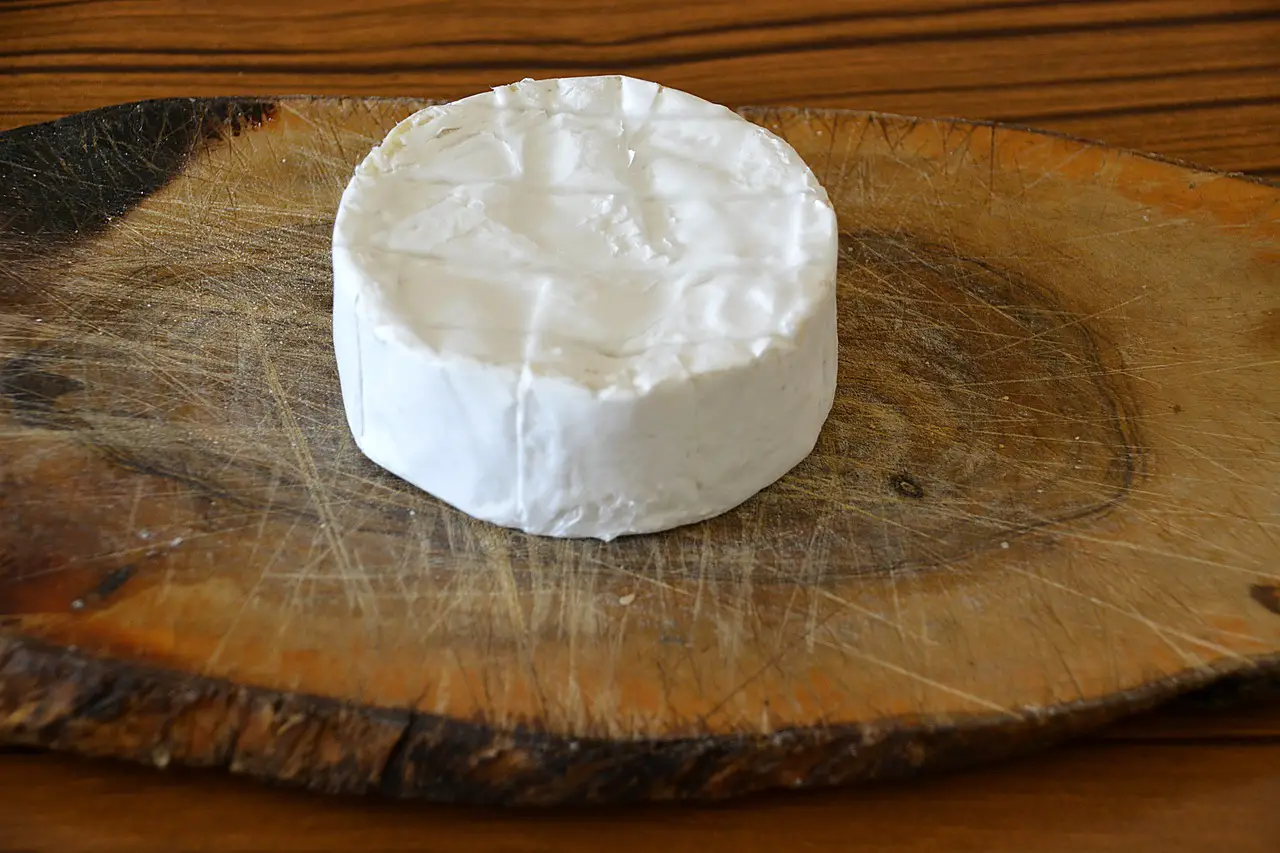Camembert is an indulgent and ooey-gooey cheese that can be eaten alone or with fruit, nuts, and spices. It pairs particularly well with sweet things, but you can also eat it with savory foods like salads and sandwiches. It’s important not to bake your Camembert too long, or it can harden up. This will ruin the texture and taste of the cheese.
Baked camembert is a simple yet indulgent cheese dish whether you’re hosting a party or want to make something for yourself. It’s a perfect sharing starter and can be served with various accompaniments, from fruit and crackers to fresh bread.
However, if you’re having trouble getting a reheated camembert to melt on your plate, you can do a few things to get the best results. The first thing you should do is score a deep cross or crosshatch pattern on the top of your camembert so that it has an opening in the middle that lets air in.

What is Camembert?
A cow’s milk cheese from Normandy, France, called Camembert, is soft, creamy, and surface-ripened. It is widely consumed and frequently reproduced, with comparable cheeses created elsewhere. Camembert has a moderate, slightly acidic flavor and a smooth, creamy core with a white, edible peel. It is frequently used in cooking or as a table cheese at room temperature.
Warm cow milk is inoculated with mesophilic bacteria, then rennet is added, and the mixture is allowed to solidify to create cheese. The curd is then put into common cylindrical camembert molds, salted, and cut into roughly 1 cm (1/2-inch) cubes. The molds are turned every six to twelve hours to ensure that the whey drains uniformly from the chopped curds. After 48 hours, each mold has a flat, cylindrical, solid cheese mass that typically weighs 250 grams (about 9 oz). The fresh cheese is now tasteless, crumbly, and hard.
How to Reheat Baked Camembert?
The procedure described below can be used to reheat baked Camembert:
- Set your oven’s temperature to 375°F (190°C).
- Remove the baked Camembert from the fridge and let it remain at room temperature for ten to fifteen minutes.
- To prevent it from drying out, put the Camembert in an oven-safe dish and wrap it in foil.
- Bake the Camembert in the oven for 10 to 15 minutes or until the cheese is melted and heated thoroughly.
- With crusty bread, crackers, or vegetables for dipping, serve the baked Camembert immediately after removing the foil.
- Reheating baked Camembert in the microwave is also an option, but the texture and flavor of the cheese can suffer as a result.
How to Freeze Baked Camembert?
By doing the following, baked Camembert can be frozen:
- After baking, let the Camembert cool completely to room temperature.
- Make sure to completely cover all exposed surfaces as you securely wrap the Camembert in plastic.
- Put the wrapped Camembert in a container or zip-top bag that is freezer-safe and sealed.
- Add a date to the container and then freeze it.
- Camembert that has been baked can be frozen for three months.
As I mentioned in my earlier response, the baked Camembert should be defrosted in the refrigerator overnight before being reheated. Be aware that after being frozen, the texture of the cheese could change a little, but it will still be wonderful!
How to Thaw Baked Camembert?
You can use the below technique to defrost cooked Camembert:
- The baked Camembert should be taken out of the freezer and put in the fridge to thaw overnight.
- Remove the Camembert from the plastic wrap once it has fully defrosted, then put it in an oven-safe dish.
- Bake the Camembert for 10 to 15 minutes, or until it is melted and heated, in an oven preheated to 375°F (190°C).
- For dipping, the baked Camembert should be served right away with crackers, veggies, or crusty bread.
It should be noted that thawing baked Camembert at room temperature risks encouraging the growth of dangerous microorganisms. Frozen cheese should always be melted in the fridge.
What is the Correct Method of Storing Baked Camembert?
The following is the proper way to store baked Camembert:
- Let the cooked Camembert cool to room temperature entirely.
- Make sure to completely cover all exposed surfaces as you securely wrap the Camembert in plastic.
- The chilled Camembert should be kept bound.
- After baking, consume the Camembert within 3 to 4 days.
You can keep the baked Camembert fresh and stop it from drying out or growing mold by properly wrapping and storing it. You can freeze any baked Camembert that you don’t plan to eat within 3–4 days by following the directions in my earlier responses.
What does Baked Camembert Tastes Like?
The flavor of baked Camembert is rich, creamy, and just a little tart. The cheese’s texture changes and becomes soft and gooey when cooked, making it simple to spread on crackers or crusty bread. The cheese’s natural flavor is also enhanced by the heat; nutty and earthy undertones are revealed, which go well with the moderate tanginess of the cheese.
The Camembert’s edible rind gives the cheese a nutty and earthy flavor that enhances its overall taste. Baked Camembert is a decadent dessert that is delightful and ideal for sharing with loved ones.
Is Baked Camembert Considered Healthy?
Like most cheeses, baked Camembert is heavy in fat and should be eaten in moderation as part of a balanced diet. Although it has some minerals, such as protein, calcium, and phosphorus, it is also heavy in saturated fat. If ingested in excess, it can elevate cholesterol levels and increase the risk of heart disease.
Additionally, a serving of baked Camembert may have a lot of calories. Therefore, it’s crucial to control your intake. Consider eating baked Camembert in smaller portions or combining it with nutritious foods like veggies or whole grain crackers if you’re watching your fat and calorie intake.
In conclusion, baked Camembert can be enjoyed in moderation as a pleasure as part of a balanced diet. However, it’s crucial to pay attention to portion sizes and balance your intake of baked Camembert with other nutritious meals.
How to Prepare Baked Camembert at Home?
Here is a straightforward method for making baked Camembert at home:
- One round of Camembert cheese is included.
- 1 to 2 tablespoons of Provence herbs (or your choice of spices)
- Olive oil, 1 tbsp
- crackers or bread with a crust for serving
Instructions:
- Turn on the oven to 400 °F (200 °C).
- Camembert cheese should be removed from its container and in a baking dish.
- The cheese should be covered with the herbes de Provence (or other herbs of your choosing).
- Olive oil should be drizzled over the cheese and herbs.
- Depending on how soft and gooey you like your cheese, bake the Camembert for 12 to 15 minutes.
- The baked Camembert should be taken out of the oven and given some time to cool.
- While it’s still warm, serve the baked Camembert with crackers or crusty toast.
This is a simple recipe that can be modified to your tastes. For more flavor, you may, for instance, bake the cheese with garlic, honey, or balsamic sauce. The Camembert must be baked long enough to become soft and gooey, making it spreadable on crackers or bread. Enjoy!
How do you Eat Camembert?
There are many ways to consume camembert; here are a few of the more common ones:
- As a cheese for a table: Camembert should be served at room temperature with crusty bread, crackers, or fresh fruit for dipping.
- Camembert can also be baked and served warm or at room temperature with crackers, veggies, or crusty bread for dipping.
- Camembert can be used as a spread or filling in sandwiches or paninis for a rich and creamy touch to your meal.
- In the kitchen, Camembert can be melted over grilled meats and vegetables or used to flavor sauces and dips.
- When it comes to wine, Camembert matches particularly well with red or white wines from the area where it was produced.
Whatever your preferred method of consumption, Camembert is a versatile cheese that is great for cooking, entertaining, or as a snack.
How to Identify Whether Baked Camembert has Gone Bad?
Baked Camembert should not be ingested if any of the following symptoms apply:
- Smell: Baked Camembert with a pungent, sour, or rancid smell has probably gone bad and shouldn’t be eaten.
- Camembert that has been baked is probably ruined if it has a slimy or crumbly, gritty quality.
- Appearance: The cheese is probably ruined if mold develops on the surface or its color changes to a darker shade.
- Taste: The baked Camembert is probably rotten if it has a sour, rancid flavor.
It’s crucial to remember that germs can quickly grow on dairy products, particularly if they have been out of the refrigerator for a long time. It’s vital to store baked Camembert carefully and to consume it within three to four days following baking to reduce the risk of contracting a foodborne illness. It is recommended to throw away and not eat the baked Camembert if you think it has gone bad.
What are the Bad Impacts of Consuming Spoiled Baked Camembert?
When spoiled baked Camembert is consumed, it can result in food poisoning and some unpleasant symptoms. Depending on the type of bacteria or toxins found in the ruined cheese, the specific symptoms may vary. However, some typical ones include:
- Nausea and diarrhea
- Diarrhea
- stomach aches and cramps
- Fever
- Headache
- muscle pain
- Weakness
When dairy products severely deteriorate, eating them might cause more severe health issues, like bacterial infection or food poisoning. It’s crucial to get medical help right away if you experience any of these after eating baked Camembert.
In conclusion, exercising caution when consuming dairy products is crucial, particularly if they have been kept outside the refrigerator for a long time or if their expiration date has passed. It is better to discard the baked Camembert and not eat it if you think it has gone bad to reduce the risk of contracting a foodborne illness.
Reference: The occurrence and growth of yeasts in Camembert and Blue-veined cheeses
Approximately 54% and 36% of retail Camembert (85 samples) and Blue-veined (45 pieces) cheese surface samples contained yeast populations larger than 106. Depending on the brand, the salt content of the surface samples of the cheeses ranged from 2.5 to 5.5% (Camembert) to 7.8 to 8.3 (Blue-veined) and impacted the yeast ecology, particularly the presence of S. cerevisiae. Candida catenulata, Candida lipolytica, Candida kefyr, Candida intermedia, Saccharomyces cerevisiae, Cryptococcus albidus, and Kluyveromyces marxianus were the most frequently isolated species.
Conclusion
Baked camembert is a creamy, gooey cheese that melts in the oven and takes on a more complex flavor. It’s a classic appetizer or dessert that’s perfect for special occasions.
It’s usually wrapped in a cardboard box and can be eaten right out of the oven, but you can also bake it without the cardboard. It can be dipped in bread or crackers and served hot. You can even do it with a fruity chutney or cranberry sauce for an extra festive touch. It can also be paired with a high acid, lightly oaked white wine such as a high-end Oregon or southern Chile chardonnay or Chenin blanc.

